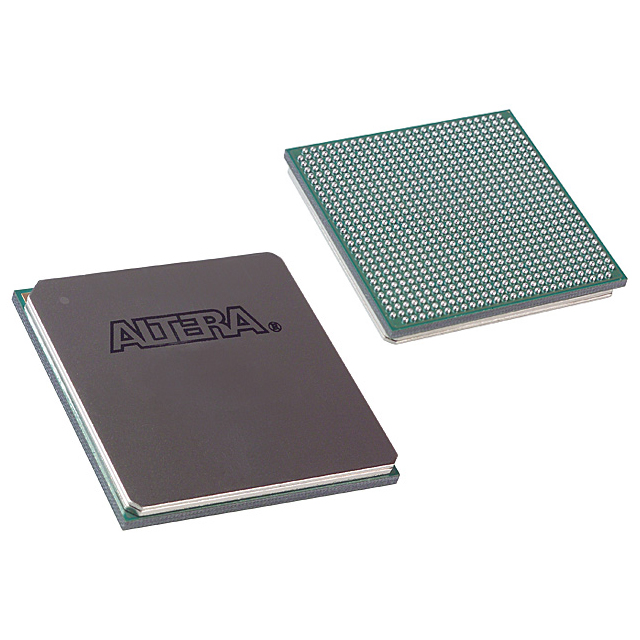

Intel
EP1S10F780C7N
FPGAs



.png?x-oss-process=image/format,webp/resize,p_30)


EP1S10F780C7N Description
The Intel EP1S10F780C7N is a high-performance, versatile field-programmable gate array (FPGA) that offers a range of features and applications for various industries. Here's a description of the model, its features, and potential applications:
Description:
The Intel EP1S10F780C7N is a member of the Intel® Stratix® 10 family of FPGAs, designed to deliver exceptional performance, power efficiency, and versatility for a wide range of applications. This device is built on a 14 nm Tri-Gate process technology, which enables higher integration, lower power consumption, and improved performance compared to previous generations.
Features:
-
High-Performance Logic Elements: The EP1S10F780C7N boasts a large number of high-performance logic elements, making it suitable for complex digital logic designs and large-scale systems.
-
Memory Resources: This FPGA features a substantial amount of memory resources, including MLABs, Register Files, and DSP blocks, which can be used for various data-intensive and computational tasks.
-
High-Speed Transceivers: The device includes high-speed transceivers that support data rates up to 40 Gbps, making it ideal for high-speed communication and data transfer applications.
-
Embedded Multi-Processor System-on-Chip (MPSoC): The EP1S10F780C7N integrates an ARM-based Intel® FPGA MPSoC, which can be used for general-purpose processing tasks, alongside the FPGA fabric for specialized, parallel processing tasks.
-
High Bandwidth Memory (HBM) Interface: The FPGA supports an HBM interface, enabling high-bandwidth, low-latency access to external memory resources.
-
Advanced I/O Capabilities: The device offers a wide range of I/O capabilities, including support for various protocols and standards, making it suitable for interfacing with a variety of external devices and systems.
-
Power Efficiency: The 14 nm Tri-Gate process technology used in the EP1S10F780C7N contributes to its power efficiency, making it suitable for applications where energy consumption is a critical factor.
-
Security Features: The FPGA includes built-in security features, such as secure boot and encryption, to protect intellectual property and ensure the integrity of the system.
Applications:
-
High-Performance Computing (HPC): The EP1S10F780C7N is well-suited for HPC applications, such as data analytics, machine learning, and scientific simulations, due to its high-performance logic elements and memory resources.
-
Telecommunications: The high-speed transceivers and advanced I/O capabilities make this FPGA ideal for telecommunications applications, including 5G infrastructure, network processing, and optical transport networks.
-
Embedded Vision: The device's processing power and I/O capabilities make it suitable for embedded vision applications, such as video processing, image recognition, and machine vision systems.
-
Automotive: The EP1S10F780C7N can be used in advanced driver-assistance systems (ADAS), autonomous vehicles, and in-vehicle infotainment systems, thanks to its processing power, security features, and reliability.
-
Industrial Automation: The FPGA's versatility and I/O capabilities make it suitable for industrial automation applications, such as motor control, robotics, and sensor integration.
-
Aerospace and Defense: The high reliability, security features, and processing power of the EP1S10F780C7N make it an excellent choice for aerospace and defense applications, including radar systems, satellite communications, and secure communications.
In summary, the Intel EP1S10F780C7N is a powerful and versatile FPGA that offers a range of features suitable for high-performance, power-efficient, and secure applications across various industries.
Tech Specifications
EP1S10F780C7N Documents
Download datasheets and manufacturer documentation for EP1S10F780C7N
 780-FBGA Pkg Info Stratix Device Datasheet Stratix Device Handbook
780-FBGA Pkg Info Stratix Device Datasheet Stratix Device Handbook  All Dev Pkg Chg 1/Aug/2018 Mult Dev Dessicant Chg 19/Jul/2019
All Dev Pkg Chg 1/Aug/2018 Mult Dev Dessicant Chg 19/Jul/2019  Virtual JTAG Megafuntion Guide
Virtual JTAG Megafuntion Guide  Mult Device EOL 1/Jun/2017
Mult Device EOL 1/Jun/2017  Mult Series Software Chgs 26/Mar/2020 Package Height 03/March/2008
Mult Series Software Chgs 26/Mar/2020 Package Height 03/March/2008 Shopping Guide


















.png?x-oss-process=image/format,webp/resize,h_32)










